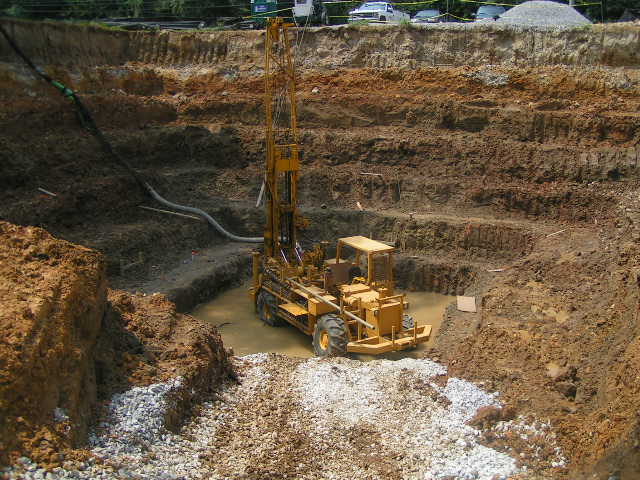Specialist Consulting Engineer Providers for Cutting-edge Infrastructure Solutions
Specialist Consulting Engineer Providers for Cutting-edge Infrastructure Solutions
Blog Article
Checking Out the Innovative Strategies and Technologies Forming the Future of the Geotechnical Market for Sustainable Engineering Solutions
The geotechnical industry is undertaking a transformative shift, driven by cutting-edge methods and technologies that highlight sustainable engineering solutions. Advanced soil stablizing techniques, the usage of smart products, and the application of data analytics are redefining exactly how we come close to facilities obstacles.
Advanced Soil Stablizing Strategies
Soil stabilization is a crucial procedure in geotechnical engineering, targeted at boosting the physical buildings of soil to enhance its load-bearing capacity and toughness. Advanced dirt stabilization methods play a crucial role in resolving challenges related to weak or unpredictable soils, therefore enabling risk-free and reliable construction methods.
Amongst the prominent methods, chemical stabilization entails using additives such as lime, cement, or fly ash, which react with dirt fragments to form a more cohesive mass. This method is especially reliable in boosting the toughness and moisture resistance of expansive clay soils. Mechanical stabilization, on the other hand, includes the physical modification of dirt buildings via compaction or the incorporation of granular materials, resulting in improved density and stability.
Another ingenious method is making use of geosynthetics, which give support and reduce soil erosion while enhancing drain. Methods like dirt blending and deep dirt stabilization are likewise gaining traction, enabling for in-situ treatment of problematic soils. Collectively, these advanced approaches not just enhance the performance of soil frameworks yet additionally add to lasting engineering methods by lessening the requirement for considerable excavation and product transport.
Smart Materials in Geotechnics
Development goes to the center of geotechnical engineering, particularly with the incorporation of clever products that enhance the performance and capability of soil structures. Smart products, such as shape memory alloys, piezoelectric materials, and self-healing polymers, are changing the method engineers come close to soil stabilization and framework durability (consulting engineer). These products can adjust to changing ecological conditions, react to stress and anxiety, and even repair themselves, considerably boosting the durability of geotechnical systems
As an example, piezoelectric products can create electrical charges in feedback to mechanical anxiety, offering possible for real-time monitoring of soil problems and structural honesty. Likewise, self-healing materials can autonomously repair fractures and damages, lowering maintenance expenses and prolonging the life expectancy of geotechnical assets. The combination of these clever materials not only boosts the mechanical buildings of soil however additionally adds to sustainable engineering methods by decreasing resource intake and ecological impact.
As the geotechnical market proceeds to evolve, the adoption of wise products will play an essential role in developing ingenious remedies, guaranteeing that facilities are not just robust but likewise adaptable to future difficulties. This transformative strategy is positioned to redefine the standards of security and efficiency in geotechnical design.
Information Analytics for Framework
The assimilation of clever materials in geotechnical engineering has led the way for sophisticated methods, specifically in the world of data analytics for infrastructure. This innovative approach leverages extensive data collection and analytical techniques to improve decision-making processes throughout the facilities lifecycle. By using sensors embedded in smart products, designers can continually check critical criteria such as dirt security, wetness levels, and structural integrity.
Data analytics makes it possible for the makeover of raw information into actionable understandings, enabling anticipating upkeep and boosted threat management. Advanced algorithms and artificial intelligence strategies promote the recognition of abnormalities and patterns, which can enhance and notify timely treatments source allotment. Additionally, integrating geographical info systems (GIS) improves spatial analysis, more enhancing the decision-making structure.
As framework projects expand in intricacy, the dependence on data analytics comes to be significantly vital. It cultivates a proactive approach, lessening the possibility of failings and guaranteeing the longevity and sustainability of structures. By harnessing the power of information analytics, the geotechnical sector is positioned to not just enhance present techniques however likewise pioneer ingenious remedies for future facilities obstacles. This synergy of innovation and engineering concepts will certainly define the future of lasting framework advancement.

Sustainable Ground Renovation Techniques
Numerous sustainable ground renovation methods are arising as important remedies to deal with the obstacles of geotechnical engineering while decreasing environmental influence. These methods not just boost soil efficiency yet also advertise ecological stewardship by decreasing dependence on traditional, much more intrusive strategies.

Another ingenious approach is the application of geosynthetics, that includes eco-friendly materials that enhance soil while advertising drainage and disintegration control - engineer of record. This reduces the requirement for heavy equipment and decreases site disturbance, hence preserving regional ecological communities
On top of that, methods such as vibrant compaction and vibro-replacement have actually evolved to include sustainable techniques, minimizing and including recycled materials carbon footprints. These techniques exhibit the sector's change towards more ecologically liable remedies, ensuring that ground enhancement not just fulfills design needs yet also contributes positively to the surrounding environment.
Advancements in Ecological Tracking
Over the last few years, innovations in ecological surveillance have actually dramatically boosted the ability to assess and manage geotechnical projects with minimal ecological disruption. Innovative innovations, such as remote sensing, Internet of Things (IoT) devices, and real-time information analytics, are changing just how ecological effects are measured and reduced.
Remote sensing technologies, consisting of satellite images and air-borne LiDAR, help with the rapid assessment of land usage adjustments and ecological conditions - geo tech engineer. These tools enable continuous surveillance of websites, enabling designers to recognize prospective issues prior to they intensify. Additionally, IoT tools, outfitted with sensing units for specifications like soil gas, moisture, and temperature level discharges, offer live information streams that improve the understanding of site-specific ecological variables
Real-time information analytics further improve decision-making procedures by integrating information from various resources, allowing for aggressive management approaches. This alternative approach not only ensures compliance with ecological policies yet also advertises sustainable methods within the geotechnical industry.
As these advancements continue to progress, they hold the potential to connect the void between engineering purposes and environmental stewardship, promoting an extra sustainable future for geotechnical jobs worldwide.
Conclusion
In final thought, the geotechnical industry is going through a transformative advancement driven by innovative methods and modern technologies that prioritize sustainability. Advanced soil stablizing approaches, the integration of smart materials, and the application of information analytics jointly enhance the resilience and effectiveness of framework. Lasting ground renovation approaches and innovations in environmental monitoring underscore the market's commitment to environmental stewardship. These improvements not just address modern engineering difficulties however likewise lead the way for a much more more information lasting future in geotechnical methods.
Techniques like dirt mixing and deep dirt stablizing are also gaining grip, enabling for in-situ therapy of troublesome soils. Jointly, these hop over to these guys sophisticated methods not just enhance the performance of dirt structures yet likewise contribute to lasting engineering techniques by lessening the need for considerable excavation and product transport.

Report this page